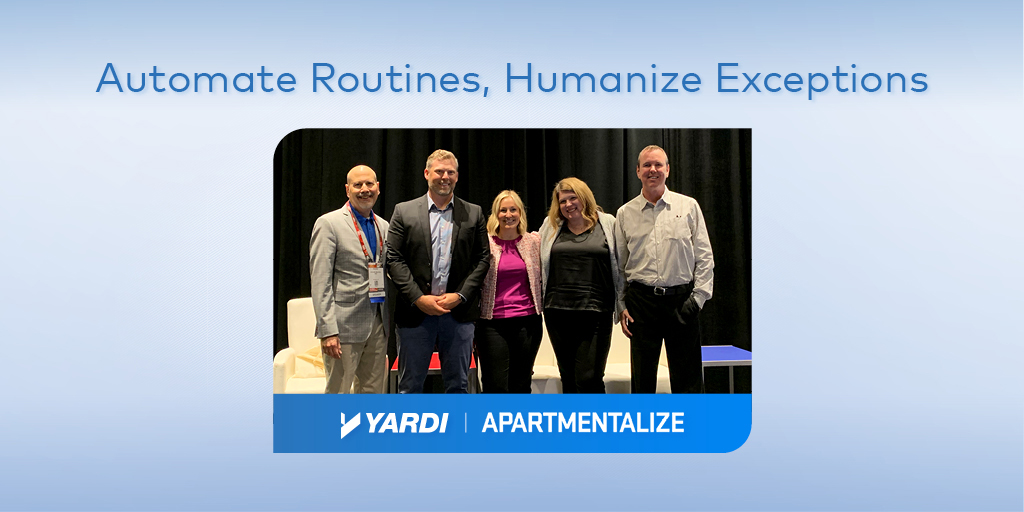By Vianna Mabanag on July 28, 2023 in Events News
At 2023 Apartmentalize powered by NAA, Yardi Vice President Richard Malpica led a panel with multifamily executives about how staffing challenges are driving the need for automation and centralization.
Meet Berkshire Residential Investments Vice President of Marketing Justin Wald, Fogelman Properties Vice President of Shared Services Kim Young, ROSS Companies Vice President of Marketing Taylor Blades and Westdale Asset Management Technology Director Jaymz Yates. What do these leading voices in multifamily have in common? They’re all leveraging technology to maximize staff satisfaction, enhance customer experiences and improve efficiencies.

Read on to learn about their challenges, strategies and how they’re taking on automation and centralization to automate routines and humanize exceptions.
Richard Malpica: What kind of staffing constraints is your company experiencing, and are there any new expectations the industry needs to adapt to?
Justin Wald: Expectations have changed for our onsite employees. They now expect being able to work from home in addition to a higher salary. On the other hand, our prospects and residents have the expectation of immediate gratification. So, we’re really taking a step back and thinking about ways to provide the right tools for everyone’s satisfaction.
Kim Young: One of the biggest things for us is onboarding. We now know to ensure that our tech is in place before a turnover occurs so the transition is as smooth as possible.
Taylor Blades: Today’s employees don’t want to spend hours working leads, handling maintenance tickets or paying invoices. I think we could improve retention if we move them away from these tasks and give them more time to make an impact with prospects and residents. Today’s employees want to be involved in higher levels of thinking, not necessarily just leasing apartments or responding to emails and answering the phone.
Jaymz Yates: I think we also need to be mindful and recognize that what we’re expecting out of our staff is different from what it was 10 years ago. We could look at it in a way where we’ve given them tools for success, but we’ve also put an additional burden on them to learn those new tools. It’s hard enough to hire staff, but now we expect them to manage multiple lines of channels and communications.
Richard Malpica: Today’s workers place a bigger emphasis on their wellbeing. How is your company providing a work experience where employees are invested, participate in more than just rudimentary tasks and feel supported by automation?
Kim Young: Our industry has a reputation of creating a pipeline where someone can start out as a leasing agent then become an assistant manager, property manager and possibly a regional vice president. But the problem is that those roles each require a different skill set. It’s not a natural progression, and that’s always been a problem. With automation, you can take a skilled leasing agent and help them deepen their practice, or help an entry-level employee excel in their field. It can be a tool to guide career paths.
Richard Malpica: Everyone is interested in what automation can do. How are you utilizing automation to attract and retain the best employees?
Taylor Blades: We might be in a position now where employee turnover is almost more costly than resident turnover. Some of the things we’re doing to add value to our employees’ work lives is removing the high-volume, low-value tasks out of their daily routine. We successfully implemented a bot that could handle leads from any channel. This helped our staff focus on building a connection with our residents, hosting events and making meaningful interactions. Our residents’ needs are aligning with our employees’ needs.
Kim Young: We’re trying to highlight the fact that automation improves our workflow. Our leasing teams are not going to suddenly not have anything to do — there’s plenty of work to go around. But our virtual assistant can handle all of those routine questions regarding pet policies and prices. It also helps us book tours, which leads to our teams giving tours and closing on leases. This not only gives us more leases, but more satisfied employees.
Justin Wald: We had the same situation where our onsite teams couldn’t handle the lead volume. Even though getting as many leads as possible is good, quality over quantity is key. We implemented automated lead nurturing so our customers get immediate gratification and our staff get some time back. They now have more time to work with residents and higher-quality leads. Automation also helps us with providing customer service on weekends.
Richard Malpica: Were there ever situations where some staff members were resistant to technology but eventually came around to it after recognizing that it would help them?
Taylor Blades: We had a few employees in the past who said there was no need for automation because they could do it themselves. But three months later, their attitudes changed because they realized that automation helped them gain more time and focus on tasks with higher importance.
Kim Young: We had a similar experience with self-guided tours. Some employees thought they would lose their jobs. But that’s not what we’re trying to do and that’s not happening. If we’re adding software, we’re trying to ease the burden for our staff while meeting customers where they are. It’s like shopping for shoes. You don’t need anyone following you around the store, but you need someone eventually when you’re ready to check out. Automation is not going to replace leasing agents. It’s going to help them.
Richard Malpica: But you also want no gaps in the customer experience. You want to avoid experiences where human leasing agents repeat the same questions bots have already asked customers. What are your experiences with this?
Jaymz Yates: If someone asks if a task can be automated and the immediate answer is yes, it’s a sign of trouble. There’s a misconception in property operations that automation is a quick fix for all problems. But the reality is that you still need to involve onsite staff — even when you have automation — so they can stay in the loop. And that’s the piece that’s going to humanize the exceptions. If you don’t give agents visibility into what’s happening, they risk asking the same questions over, which can lead to a poor customer and staff experience.
Richard Malpica: Good point — this is why we built the “Communication Hub” into our CRM. It’s a centralized view of all communication threads from prospects and residents. Whenever a person chats, texts, emails or calls, human leasing agents can see the entire customer history and pick it up from there. This creates a seamless transition from online to in-person interactions. Which leads me to the next question: How is your company navigating the idea of centralizing processes?
Kim Young: We’re still in a discovery phase of centralization, but the most important thing I can share from this experience is that you have to figure out your automation strategy before you can figure out your centralization strategy. Until you know what humans don’t have to do, you can’t know how and where to centralize. So, prioritize automation and centralization will be easier.
Justin Wald: We’re creating remote opportunities and providing offsite possibilities for our staff. But it’s important that someone is physically present so we have a human element for onsite communication. Overall, centralization offers growth and expansion that didn’t exist previously. But we need to make sure that we provide our staff the necessary tools and support.
Taylor Blades: There’s a big difference between centralizing tasks and centralizing physically. We don’t have communities within five miles of each other but we’re trying to centralize as many tasks as possible with automation.
Jaymz Yates: Centralization looks different now from when we first brought it up months ago. It can be as small as centralizing your customer experience support to a brick-and-mortar office. For us, this is a good time to weigh the benefits and acknowledge that our staff will require a lot of support.
Richard Malpica: We spoke about centers of excellence and enabling skill development for role specialization before this panel. How are you taking advantage of this opportunity?
Taylor Blades: I think it’s all about meeting customers where they are. Nobody might want help when shopping for new shoes, but they might want help doing their taxes. Prospects may not always need human interactions, but they will need it eventually. And when that time does come, we want it to be meaningful. Centralization and creating these centers of excellence is eventually going to help us meet customers where they are.
Justin Wald: Centralization is an opportunity for us to increase brand awareness. With centralized leasing, for instance, we can assist potential tenants based on what’s available in our portfolio. In the past, we had to focus solely on our individual properties, but now we can better serve their needs.
Richard Malpica: What’s your biggest takeaway from this discussion?
Taylor Blades: The importance of getting buy in from the on-site team for automation resonated with me. It’s important to explain the value of the new technology and involve staff in the process, even if it takes a bit longer. This can help us improve long-term collaboration.
Jaymz Yates: Make sure that onsite staff can easily adapt to automation and be effective without facing negative impacts. Involve every property and consider the possibility that their actual process may differ from your corporate policy.
Kim Young: Don’t just automate to shift work from one person to another. That’s not what automation means. Utilize the tech available to you to streamline your process, whatever that may look like.
Justin Wald: You need to provide your staff with support and tools to be successful so you can be successful.
Want more insights on how you can ease staffing challenges with automation and centralization? Connect with us to discover tech that can help you retain high-quality staff, create exceptional customer experiences and boost NOI across your portfolio.


